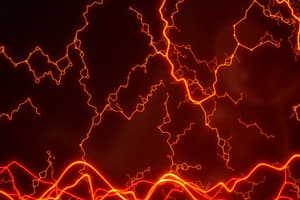Podcast
Questions and Answers
Dove avviene il metabolismo aerobico all'interno delle cellule muscolari?
Dove avviene il metabolismo aerobico all'interno delle cellule muscolari?
- Nei lisosomi
- Nei mitocondri (correct)
- Nel citoplasma
- Nel nucleo
Quale processo genera energia attraverso la rottura del glucosio o degli acidi grassi nel metabolismo aerobico?
Quale processo genera energia attraverso la rottura del glucosio o degli acidi grassi nel metabolismo aerobico?
- Fosforilazione ossidativa (correct)
- Trasporto degli elettroni
- Glicolisi
- Ossidazione del piruvato
Quale è la principale fonte di energia nel metabolismo anaerobico?
Quale è la principale fonte di energia nel metabolismo anaerobico?
- Fibre muscolari
- Amminoacidi
- Proteine
- Glucosio (correct)
Qual è il numero di stadi nel percorso del metabolismo aerobico?
Qual è il numero di stadi nel percorso del metabolismo aerobico?
Per quale gruppo di individui è cruciale comprendere i percorsi metabolici aerobici e anaerobici?
Per quale gruppo di individui è cruciale comprendere i percorsi metabolici aerobici e anaerobici?
Quale delle seguenti affermazioni è corretta riguardo alla catena di trasporto degli elettroni durante il processo metabolico aerobico?
Quale delle seguenti affermazioni è corretta riguardo alla catena di trasporto degli elettroni durante il processo metabolico aerobico?
Quale delle seguenti caratteristiche differenzia l'attività metabolica aerobica dall'attività metabolica anaerobica?
Quale delle seguenti caratteristiche differenzia l'attività metabolica aerobica dall'attività metabolica anaerobica?
Qual è il ruolo principale del percorso della pentosio-fosfato (PFP) nell'attività metabolica anaerobica?
Qual è il ruolo principale del percorso della pentosio-fosfato (PFP) nell'attività metabolica anaerobica?
Perché l'attività metabolica anaerobica risulta più veloce dell'attività metabolica aerobica?
Perché l'attività metabolica anaerobica risulta più veloce dell'attività metabolica aerobica?
Qual è il ruolo principale del NADPH prodotto nel percorso della pentosio-fosfato nell'attività metabolica anaerobica?
Qual è il ruolo principale del NADPH prodotto nel percorso della pentosio-fosfato nell'attività metabolica anaerobica?
Flashcards are hidden until you start studying
Study Notes
Aerobic and Anaerobic Metabolism: Physiological Basis and Training Methodologies
Aerobic and anaerobic metabolic pathways are essential processes that occur within our cells, particularly in muscle fibers, to produce energy for various activities. These processes differ in their requirements for oxygen and the types of molecules they utilize. Understanding these two metabolic pathways is crucial for athletes and fitness enthusiasts looking to optimize performance and recovery, as well as health professionals aiming to support the maintenance of overall physical function. In this article, we will delve into the details of aerobic and anaerobic metabolism, including their physiological basis and how they can influence training methodologies.
Aerobic Metabolism
Aerobic metabolism, also known as cellular respiration, occurs in the presence of oxygen. This process generates energy through the breakdown of glucose or fatty acids, which releases large amounts of energy in the form of ATP (adenosine triphosphate) molecules. The primary locations where aerobic metabolism takes place are the mitochondria inside muscle cells.
The aerobic metabolic pathway consists of three stages: glycolysis, pyruvate oxidation, and the electron transport chain. Glycolysis is the initial step where glucose is broken down into smaller molecules called pyruvate. Pyruvate enters the mitochondrial matrix, where it undergoes oxidative decarboxylation, producing NADH (nicotinamide adenine dinucleotide) and FADH2 (flavin adenine dinucleotide), both of which are involved in the electron transport chain.
During the electron transport chain, electrons are transferred from NADH and FADH2 to molecular oxygen via a series of protein complexes embedded in the inner mitochondrial membrane. As electrons flow through this system, protons are pumped out of the mitochondrial matrix, creating a proton gradient across the inner membrane. The energy stored in this proton gradient is used to drive the synthesis of ATP via chemiosmosis, a passive process that creates another ATP (via substrate-level phosphorylation) on top of the ATP generated during the electron transfer reactions.
Aerobic metabolism produces significantly more ATP per unit area compared to anaerobic metabolism, making it the most efficient source of ATP production for sustained physical activity. For example, when running at a steady pace, the body relies primarily on aerobic metabolism to generate the necessary energy. However, there are certain limitations to aerobic metabolism's ability to supply energy quickly enough to meet sudden bursts of high-intensity exercise.
Anaerobic Metabolism
Anaerobic metabolism, on the other hand, does not require oxygen and can take place much faster than aerobic metabolism. It is carried out predominantly in the cytoplasm of cells, especially in skeletal muscle cells. There are two main forms of anaerobic metabolism: glycolysis (which was described earlier) and the pentose phosphate pathway.
Glycolysis, which occurs in both aerobic and anaerobic conditions, ultimately breaks down one molecule of glucose into two molecules of pyruvate. During glycolysis, glucose is converted into two ATP molecules, while four additional ATP molecules are produced later by the electron transport chain and the synthesis of glycogen (the storage form of glucose).
In contrast, the pentose phosphate pathway, also known as the hexose monophosphate shunt or HMP pathway, involves the conversion of glucose-6-phosphate into ribulose-5-phosphate. Along with providing precursors for nucleotide biosynthesis, this pathway yields NADPH (nicotinamide adenine dinucleotide phosphate), which plays a critical role in maintaining redox balance in cells during periods of high energy demand.
Compared to aerobic metabolism, anaerobic metabolism has several characteristics:
- Speed: Anaerobic metabolism is quicker than aerobic metabolism because it doesn't rely on the slow electron transport chain or the need for sufficient oxygen availability.
- Energy Yield: While glycolysis produces less ATP per molecule of glucose than aerobic metabolism, its speed allows it to contribute to short bursts of intense activity.
- Byproduct Formation: Both lactic acid and pyruvate are byproducts of anaerobic metabolism; however, only lactate accumulates under anaerobic conditions, leading to a decrease in pH levels, which in turn reduces the rate of glycolysis and promotes the return to aerobic metabolism.
Physiological Basis
Understanding the physiological basis of aerobic and anaerobic metabolism is crucial for developing effective training methods. Some key points regarding the physiological basis include:
-
Muscle Fiber Type: Muscles contain both fast-twitch and slow-twitch fibers, each capable of supporting either aerobic or anaerobic metabolisms depending on the type of exercise performed. Fast-twitch fibers are best suited for brief, high-intensity exercises, such as sprinting, while slow-twitch fibers are better adapted for endurance activities like jogging or swimming.
-
Fatigue: Fatigue occurs when the rate of energy expenditure exceeds the rate of energy production. During aerobic exercise, fatigue typically results from a decline in efficiency due to factors like dehydration, heat stress, poor nutrient intake, and reduced blood flow to active muscles. Anaerobic exercise leads to fatigue due to the buildup of lactic acid, which lowers the pH of the muscle tissue, reducing the rate of glycolysis and promoting the transition back to aerobic metabolism.
-
Training Adaptations: Regular training can lead to adaptations in both aerobic and anaerobic systems. Aerobic exercise increases the number of capillaries and mitochondria, improving oxygen delivery and
Studying That Suits You
Use AI to generate personalized quizzes and flashcards to suit your learning preferences.




